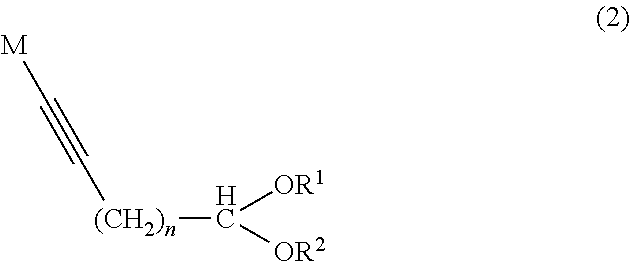Method of producing aliphatic aldehyde compound having terminal conjugated diene structure and intermediate therefor
a technology of conjugated diene and compound, which is applied in the preparation of carbonyl compound, sulfonic acid esters, organic chemistry, etc., can solve the problems of difficult to obtain high-purity terminal diene, geometric isomerization of double bond, and inability to easily industrially produce acrolein to be used as a raw material, etc., to achieve good purity and good yield
- Summary
- Abstract
- Description
- Claims
- Application Information
AI Technical Summary
Benefits of technology
Problems solved by technology
Method used
Image
Examples
example 1
(n=6, R1═CH2CH3, R2═CH2CH3, and Methylmagnesium Chloride as the Metal Reagent)
[0101]In a nitrogen atmosphere, a solution of methylmagnesium chloride (38.59 g:0.516 mol) in tetrahydrofuran (160.99 g) was placed in a reactor, and stirred at a solution temperature of 50 to 55° C. The resulting solution was subjected to dropwise addition of 8-nonynal diethyl acetal (1) (89.03 g:0.3967 mol) at a solution temperature of 55 to 60° C. over 30 minutes, and then stirred at 60 to 65° C. for 6 hours. The reaction solution was cooled to 55° C. or less and provided for a subsequent step.
example 2
(n=6, R1═CH2CH3 and R2═CH2CH3)
[0102]The solution of the organic metal compound (2) prepared in Example 1 was subjected to dropwise addition of ethylene oxide (27.93 g:0.635 mol) at a reaction solution temperature of 50 to 60° C. over 45 minutes, and then stirred at 50 to 60° C. for 3 hours. The reaction solution was cooled to 50° C. or less, subjected to addition of pure water (500 g), acetic acid (48 g) and hexane (100 g), and then stirred for 30 minutes. The organic phase separated was subjected to typical work-up of washing, drying and concentration to obtain an intended crude product (110.01 g). The crude product was distilled under reduced pressure to obtain the intended 11-hydroxy-8-undecynal diethyl acetal (3) (85.56 g:0.558 mol). The total yield of those two steps calculated based on the sum of “weight multiplied by purity” with respect to all the fractions including the fractions obtained in the previous distillation was 91.98%.
11-Hydroxy-8-undecynal diethyl acetal (3)
[010...
example 3
(n=9, R1═CH2CH3, R2═CH2CH3, and Methyl Magnesium Chloride as the Metal Reagent)
[0108]In a nitrogen atmosphere, a solution of methylmagnesium chloride (63.05 g:0.843 mol) in tetrahydrofuran (263.16 g) was placed in a reactor, and stirred at a solution temperature of 50 to 55° C. The resulting solution was subjected to dropwise addition of 11-dodecynal diethyl acetal (1) (196.84 g:0.6484 mol) at a solution temperature of 55 to 60° C. over one hour, and then stirred at 60 to 65° C. for 6 hours. The reaction solution was cooled to 55° C. or less and provided for a subsequent step.
PUM
 Login to View More
Login to View More Abstract
Description
Claims
Application Information
 Login to View More
Login to View More - R&D
- Intellectual Property
- Life Sciences
- Materials
- Tech Scout
- Unparalleled Data Quality
- Higher Quality Content
- 60% Fewer Hallucinations
Browse by: Latest US Patents, China's latest patents, Technical Efficacy Thesaurus, Application Domain, Technology Topic, Popular Technical Reports.
© 2025 PatSnap. All rights reserved.Legal|Privacy policy|Modern Slavery Act Transparency Statement|Sitemap|About US| Contact US: help@patsnap.com



